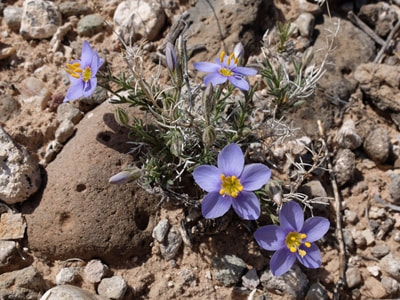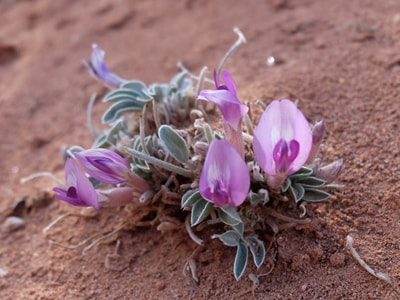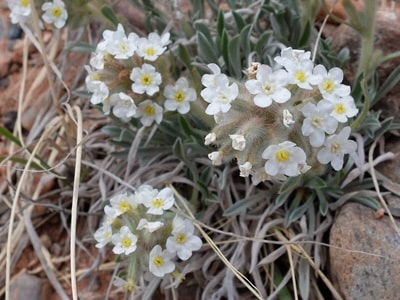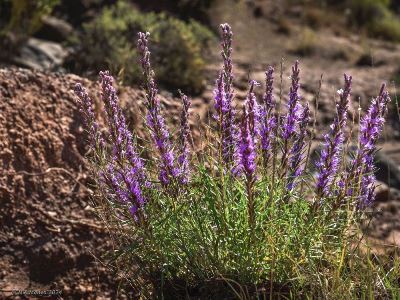|
The Bloom Blog Blooming this week in the environs of Abiquiú By Wildflowers of the Southern Rocky Mountains Found in sandy openings
Seen blooming in April in Plaza Blanca Turkey Peas stems grow from two to ten inches sprawling in a mat or erect. Stems are reddish and hairy. Leaves are on long stems and have 7-15 hairy leaflets. Tiny flowers, about 1/4 inch wide, have purple banners with a white center. Seed pods are red and slightly curved, about ½ inch long. No edible or medicinal uses were found on the internet, nor the reason for the common name Turkey Peas. A Google search found five other plants with the common name of Turkey Peas, multiple recipes using turkey and peas, and dog food. If you trying to identify a different flower then you can check what other flowers bloom this month. If you cannot identify a flower from the website send a photo and where you took it to [email protected]. Read online for tips.
0 Comments
Spiny Blue Bowls, Desert Blue Gilia, Bluebowls Giliastrum acerosum Phlox Family (Polemoniaceae)4/16/2025 The Bloom Blog Blooming this week in the environs of Abiquiú By Wildflowers of the Southern Rocky Mountains Spiny Blue Bowls, Desert Blue Gilia, Bluebowls
Giliastrum acerosum Phlox Family (Polemoniaceae) Found in dry, open, gravelly areas Seen blooming in April in Poshuouinge, Santa Fe NF Although it grows only three to six inches tall Spiny Blue Bowls are noticeable because of their deep blue flowers. Flowers are ½ inch across with a bright yellow center. Leaves are needle-like and stems woody. Native Americans massaged the crushed plant on cramping muscles. Source. If you are trying to identify a different flower then you can check what other flowers bloom this month. If you cannot identify a flower from the website, send a photo and where you took it to [email protected]. Read online for tips. The Bloom Blog Blooming this week in the environs of Abiquiú By Wildflowers of the Southern Rocky Mountains Newberry’s Milkvetch
Astragalus newberryi var. newberryi Pea Family (Fabaceae) Found in sandy, dry areas Seen blooming in April on Chimney Rock Trail at Ghost Ranch This beautiful little plant grows low to the ground with 5 to 11 silky leaflets. Flowers are showy, bright pink/purple with a lighter center and are over one inch long. Seed pods are curved and covered in silky, white hairs. Traditional uses for Newberry’s Milkvetch are unknown, but other Milkvetch species have uses. The plant is considered poisonous, especially to stock and horses, however medicinally; a decoction of the whole plant was used as a wash for the head, hair and whole body, for stomach disorders, as a gargle for sore throats, a poultice of crushed leaves applied to a lame back, applied as an ointment for animals with urination troubles, roots were chewed as a cathartic, an infusion of root was used as a wash for sores and as a wash for granulated eyelids and toothaches, also plants were used as a ceremonial emetic, the seeds used for food, and pounded seeds mixed with other foods and used as a spice. Source. If you are trying to identify a different flower then you can check what other flowers bloom this month. If you cannot identify a flower from the website, send a photo and where you took it to [email protected]. Read online for tips. The Bloom Blog Blooming this week in the environs of Abiquiú By Wildflowers of the Southern Rocky Mountains Found in sunny, sandy, dry areas, waste ground
Seen blooming in April in Red Wash Canyon The Borage family are low growing, densely hairy plants and have flowers with five petals. Cryptanthas are distinguished by their tiny white clusters of flowers with a yellow center, the “eye”. They are commonly known as Cat’s Eyes. Plants will often show last year’s dried stems and leaves. This one grows to about 6 inches high in clumps. Native Americans, specifically the Navajo, used Tawny Cat’s Eye for medicinal purposes: a decoction of plants was taken at childbirth, a cold infusion was used to treat snakebites, a poultice applied for toothaches and the plants were chewed for coughs and colds. Source. If you are trying to identify a different flower then you can check what other flowers bloom this month. If you cannot identify a flower from the website, send a photo and where you took it to [email protected]. Read online for tips. The Bloom Blog Blooming this week in the environs of Abiquiú By Wildflowers of the Southern Rocky Mountains Image Courtesy of Mario Manzo
Found in open sandy and rocky areas Seen blooming in September in Red Wash Basin Dotted Blazing Star grows to 32 inches with unbranched stems and narrow leaves. Small lavender to pale pink flowers grow in narrow spikes that bloom from the top down. It has a remarkable root system with lateral branches extending to 5 feet and the taproot reaching up to 16 feet. Domestic livestock like the Dotted Blazing Star, particularly sheep. Elk and White-Tail Deer also eat it; it is sometimes called Deer Potatoes. A variety of small rodents like it, especially the roots, and it is the only source of food for some butterflies. Native Americans used the plant for food and medicinal purposes. The root was boiled or baked before eating. Plains tribes used the Dotted Blazing Star to make a tea that was used for kidney, bladder, and menstrual problems, water retention, gonorrhea, colic, sore throat and laryngitis. Mashed roots were applied to snake bites. Dry roots were burned like incense to relieve headaches, nosebleeds, and tonsillitis. Source. If you are trying to identify a different flower then you can check what other flowers bloom this month. If you cannot identify a flower from the website, send a photo and where you took it to [email protected]. Read online for tips. |
AuthorI am Marilyn Phillips, a native of England, whose love of nature and the outdoors from childhood brought me by a circuitous route to Crested Butte, Colorado in 1993 and 16 years later to northern New Mexico. My exploration of the many trails in these areas, my interest in wildflowers and photography, and career in computer system design came together in this creation. If you have any corrections, comments or questions, please contact me by email. Archives
July 2025
Categoriescopyright © 2020
|







 RSS Feed
RSS Feed